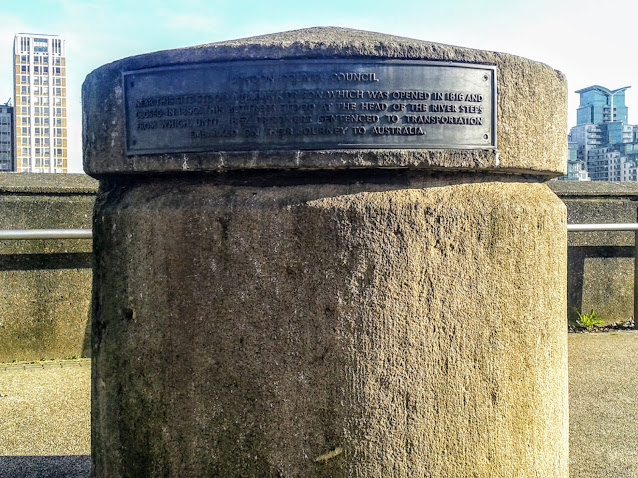 |
| From Here to Australia. |
Saturday March 8, 2014.
It was during one of my wanders along the north bank, of the River Thames, from Battersea to Westminster, that I spotted this bollard. The inscription, read...
"Near this site stood Millbank Prison which was opened in 1816 and
closed in 1890. This buttress stood at the head of the river steps
from which, until 1867, prisoners sentenced to transportation
embarked on their journey to Australia."
Brief History
Millbank Prison, or the National Penitentiary, was built between 1812 and 1821, although the first prisoners, all female, were admitted in 1816. The first male inmates arrived in January 1817.
The design of the prison was six separate pentagons linked together, forming a symmetrical flower shape. At its heart was the chapel.
In 1822-23 an epidemic spread through the building, resulting in the building being evacuated: the female inmates were released, while the men were transferred to floating prisons, in Woolwich.
The design of the building was highly unsatisfactory in that It had so many corridors that prison warders often got lost, and, the ventilation allowed sound to carry so well that the inmates had no issue with communicating with each other.
In 1842 the newly built Pentonville Prison became the National Penitentiary, which resulted in Millbank Prison being downgraded to a holding prison, for those awaiting transportation. This would continue until 1867, before transportation ended, and Millbank Prison became a Local Prison. It then became a Military Prison, in 1870.
The last inmate left the building in 1886 and it was finally closed down in 1890.
Demolition of the building began in 1892 and would continue until 1903.
The design of the prison was six separate pentagons linked together, forming a symmetrical flower shape. At its heart was the chapel.
In 1822-23 an epidemic spread through the building, resulting in the building being evacuated: the female inmates were released, while the men were transferred to floating prisons, in Woolwich.
The design of the building was highly unsatisfactory in that It had so many corridors that prison warders often got lost, and, the ventilation allowed sound to carry so well that the inmates had no issue with communicating with each other.
In 1842 the newly built Pentonville Prison became the National Penitentiary, which resulted in Millbank Prison being downgraded to a holding prison, for those awaiting transportation. This would continue until 1867, before transportation ended, and Millbank Prison became a Local Prison. It then became a Military Prison, in 1870.
The last inmate left the building in 1886 and it was finally closed down in 1890.
Demolition of the building began in 1892 and would continue until 1903.
No comments:
Post a Comment